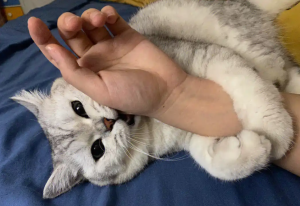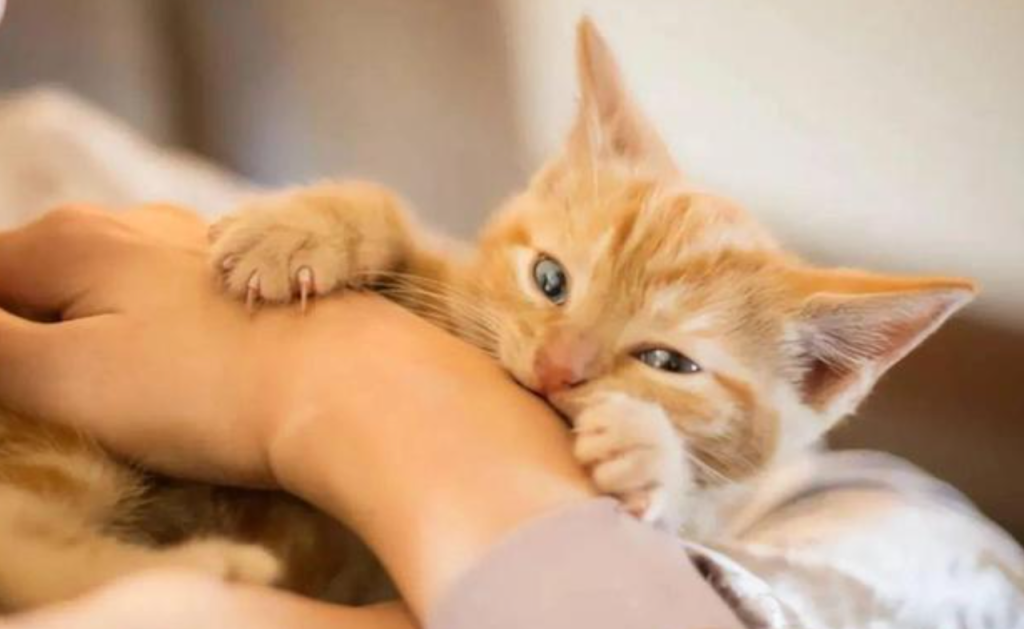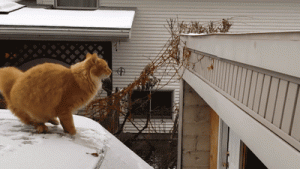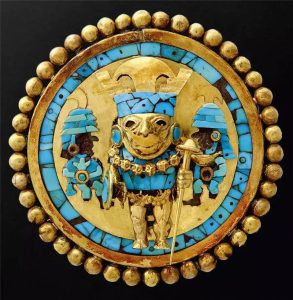A cat owner messaged me, saying, “Now you’re telling me this is a kitten’s ‘playful bite,’ but what about before, when I slapped its face and poked its throat? What was that?” Yesterday, another cat owner sent me a message saying their mischievous cat kept biting and kicking like a rabbit. The cat owner didn’t move their hand, but the cat bit harder and harder, causing pain, though it didn’t break the skin. The owner was controlling the cat’s boundaries, but is this considered a playful bite?Today, let’s break it down: How can we tell the difference between a cat’s fake bite and a real bite?
-
Force of the Bite
Playful Bite: You can feel the cat controlling its bite strength. Some particularly excited cats may have less control, making the bite feel a bit painful, but it never breaks the skin or causes bleeding.Aggressive Bite: The bite is much stronger, and you’ll feel a sharp or even intense pain. Often, there will be visible tooth marks, broken skin, or even bleeding. The cat lacks control over the force, and it’s a true “bite to hurt.”
-
Body Language and Overall State
Playful Bite:Relaxed State: The body is typically relaxed, without noticeable tension or stiffness.Accompanying Playful Behavior: Usually happens during play, like pouncing at your hands/feet or biting while playfully gripping you, possibly accompanied by kicking with its hind legs (similar to a “rabbit kick” during hunting).Pleasure Signals: The cat may purr (although purring can also occur during stress, in the context of play, it usually indicates happiness).Ears and Whiskers: Ears are typically forward or in a neutral position, whiskers are relaxed or slightly forward.Tail: The tail may sway gently (indicating excitement) or remain in a relaxed position.Aggressive Bite:Tense/Attack State: The body is stiff, muscles are tense, back arched, fur standing up.Warning Signals: Before the bite, there are usually clear warning signs, such as flattened ears (airplane ears), dilated pupils, low growls or hissing, and the tail flicking or puffing up.Purpose: The bite is meant to stop a behavior the cat dislikes (such as being petted in a spot it doesn’t like, being forced to cuddle, getting nails clipped, or being disturbed while resting/eating), or it’s a defensive response due to fear or pain.Ears and Whiskers: Ears are typically pulled back (airplane ears), whiskers are either pulled back or tense.Tail: The tail may lash back and forth forcefully or puff up in anger.
-
Sounds
Playful Bite: Usually quiet or accompanied by a playful “meow” during play.Aggressive Bite: Before or during the bite, the cat may make low growls, hissing, or angry yowls.

-
Context
Playful Bite:Happens during interactive play or when you’re actively teasing the cat with your hands (though it’s not recommended to use hands and feet to tease cats — honestly, some cats don’t respond to gentle advice).The cat appears relaxed and happy, enjoying the moment.Aggressive Bite:Occurs when you do something the cat dislikes (forcing it to be petted, held, groomed, clipped, or interrupting its rest/eating).Happens when the cat feels scared or threatened (e.g., strangers approaching or other animals intimidating it).Happens when the cat experiences physical discomfort (like from an injury or illness).Occurs during resource guarding (such as protecting food).Happens when the cat feels cornered and has no escape (defensive attack).
-
Duration
Playful Bite: Typically brief, either a single nip or a few quick bites before letting go, or it may just hold your hand without biting.Aggressive Bite: The cat may hold on, continuing to bite hard or repeatedly.
-
How to Respond
Playful Bite:Stop Interaction Immediately: When the cat starts to “fake bite,” stop playing or petting, and keep your hand/foot completely still (like playing dead), or simply walk away. This teaches the cat that “bite = play is over.”Provide an Alternative: When the cat tries to bite, immediately offer a suitable toy (like a wand toy or a small mouse toy) to redirect its hunting instinct onto the toy.Loudly Express Discomfort: You can mimic the sharp “yow!” sound a cat makes when hurt to signal that it caused you pain. This works for bolder cats or those that have a high level of trust in you.Aggressive Bite:First Priority: Protect yourself and stop the source of stimulation! Don’t pull away violently (which may worsen the wound), but gently push your hand/foot toward the cat to encourage it to release. Keep calm to avoid exacerbating the injury.Aftercare: Clean the wound thoroughly (cat bites are prone to infection) and seek medical attention if necessary.Identify the Cause: What made the cat uncomfortable? Is it fear, pain, or something forced upon it? Addressing the root cause is key to resolving the issue.Avoid Repeating the Same Triggering Situations: If biting occurs frequently, consult a veterinarian to rule out pain or illness, and reach out to a professional cat behaviorist.
So, fellow cat owners, does your cat have a “playful bite” or a “bite to hurt”? Can you tell the difference now? Feel free to share your experiences, along with pictures, in the comments section!





